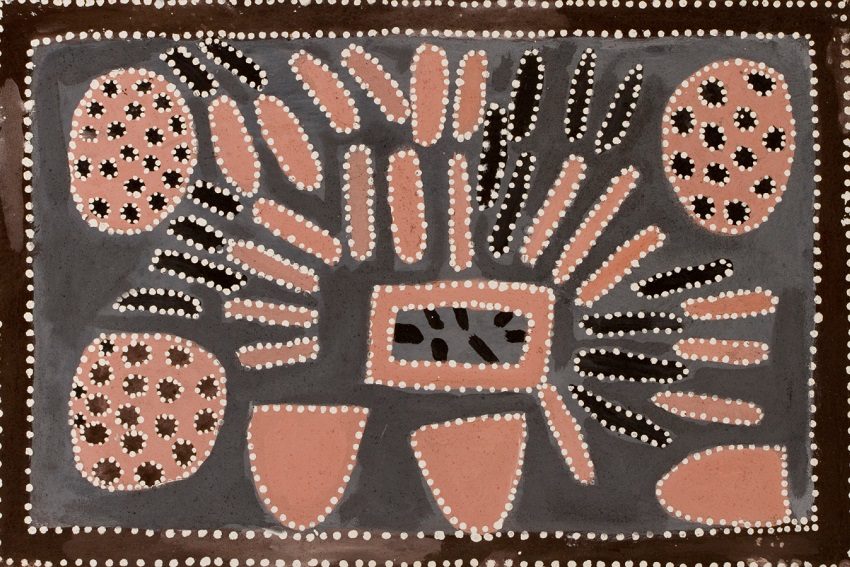A Thousand Journeys two decades on

A Thousand Journeys: the Helen Read Collection currently showing at the Flinders University City Gallery, revisits a touring exhibition, originally conceived in 1998.
Twenty years on, and with hindsight, this current iteration enables audiences to see the influence of some of the key Aboriginal artists of the 20th century.
It features more than 60 works from across the Kimberley and Top End, including signature pieces by Rover Thomas (c.1926–1998), Queenie McKenzie (c.1915–1998), Kitty Kantilla (c.1928–2003), Eubena Nampitjin (c.1925–2013) and David Malangi (1927–1999).
“It features artists that are almost household names now but at the time they were carving a path for contemporary Indigenous art practice as we know it today,” says Flinders University Art Museum director Fiona Salmon.

A Thousand Journeys: The Helen Read Collection, installation view, Flinders University City Gallery 2017
The original exhibition, curated by Pauline Guthrie for Tin Sheds Gallery at The University of Sydney in 1998, travelled the east coast before ending up in Adelaide in 2001. At this time, Aboriginal art was mostly viewed in museums and a large portion of the art still fitted into the dot painting movement.
“The original exhibition was meant to introduce a wider audience to the complexity and diversity of Aboriginal art practice,” she says. “It was also highlighting the distinct regional styles of the Kimberley, Arnhem Land and the Western Desert.”
Fast forward 20 years to today and the latest exhibition, pitched to be run during the 2017 Tarnanthi Festival of Contemporary Aboriginal and Torres Strait Islander Art, still focuses on the diversity of Aboriginal art but presents it in a different framework.
“I felt Tarnanthi had a very contemporary focus, looking at the here and now,” Salmon says. “This work is contemporary but slightly older so it adds a really nice historical frame for what we are viewing today through Tarnanthi.”
 Richard Tax Tjupurrula, Untitled c1993, synthetic polymer paint on canvas, 1000 x 500 mm, Helen Read Collection
Richard Tax Tjupurrula, Untitled c1993, synthetic polymer paint on canvas, 1000 x 500 mm, Helen Read Collection
The works have been grouped according to their regional affiliation which highlights the diversity of Aboriginal art practice across the different Indigenous art centres and the areas they serve. For example, walking into the exhibition one is immediately struck by a number of vivid paintings easily recognisable as artists from Balgo Hill.
“They are very striking and vibrant. There is a looseness to the work coming from Balgo Hill,” Salmon says. “I remember at the time it really stood apart, it felt like a breakaway from the past.”
The Northern Arnhem Land and Elcho Islands section features the x-ray style of painting, which can be traced back to rock painting. This style often depicts fish and mammals showing their interior which is meant to teach younger generations of hunters about their prey. Bardayal “Lofty” Nadjamerrek’s stunning paintings are a wonderful example of this with their light and delicate nature.

Muntja Nungurrayi, Eubena Nampitjin and Susie Bootja Bootja Napaltjarri, A Thousand Journeys: The Helen Read Collection, installation view, Flinders University City Gallery 2017
Also eye catching are the abstract landscapes of Rover Thomas and Freddie Timms from the Kimberley Region. The pared back palettes and solid block shapes created a unique style that was very different to other depictions of the landscape at the time.
The latest presentation of this group of works also highlights the role of women and how important they were in the contemporary Aboriginal art movement.
“It wasn’t as evident in the original exhibition but we can see now that by the mid ‘80s/’90s painters such as Emily Kngwarreye and Lorna Fencer were important voices so we wanted to be able to bring that out through the show,” Salmon says.
The first time A Thousand Journeys was presented to audiences in 1998 the Aboriginal contemporary art movement was still emerging, but the aim remains the same today: to celebrate the most talented Aboriginal artists and highlight the timeless nature of their work.
A Thousand Journeys: The Helen Read Collection
Flinders University City Gallery
Until Sunday, February 11
artmuseum.flinders.edu.au
Header image: Queenie Nakarra McKenzie, Children’s Picnic 1996, ochres on canvas, 600 x 900 mm, Helen Read Collection